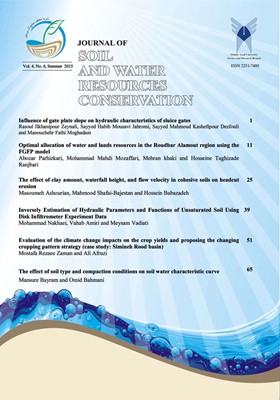The effect of soil type and compaction conditions on soil water characteristic curve
Subject Areas : Farm water management with the aim of improving irrigation management indicatorsMansure Bayram 1 , Omid Bahmani 2
1 - MSc. Department of Water Engineering, Faculty of Agriculture, Bu-Ali Sina University, Hamadan, Iran
2 - Assistant Professor, Department of Water Engineering, Faculty of Agriculture, Bu-Ali Sina University, Hamadan, Iran
Keywords: soil plasticity, soil water retention, suction, water content,
Abstract :
Quantitative evaluation of soil compaction to improve agricultural management practices and reduce the problems caused by compaction in the environment and production is essential, and such factors as compaction effort, soil type (%clay and soil plasticity) and water content condition have a significant impact on soil compaction. This research was conducted to study the effect of soil type and compaction on soil water characteristic curve with factorial experiment using randomized complete block design and 27 treatments were provided. Treatments consisted of three soil types: clay, clay loam and sandy loam under three compaction conditions: reduced, standard, and modified were performed. The compactions were performed in the three moisture conditions: dry, optimum and wet and undisturbed samples were provided as control. Mean comparison was conducted using Duncan's test and statistical analysis was performed by SAS statistical. The results showed that at all potentials, the influence of soil type on soil water retention was significant at the p Quantitative evaluation of soil compaction to improve agricultural management practices and reduce the problems caused by compaction in the environment and production is essential, and such factors as compaction effort, soil type (%clay and soil plasticity) and water content condition have a significant impact on soil compaction. This research was conducted to study the effect of soil type and compaction on soil water characteristic curve with factorial experiment using randomized complete block design and 27 treatments were provided. Treatments consisted of three soil types: clay, clay loam and sandy loam under three compaction conditions: reduced, standard, and modified were performed. The compactions were performed in the three moisture conditions: dry, optimum and wet and undisturbed samples were provided as control. Mean comparison was conducted using Duncan's test and statistical analysis was performed by SAS statistical. The results showed that at all potentials, the influence of soil type on soil water retention was significant at the p


